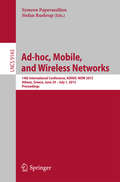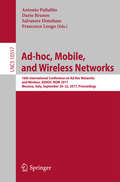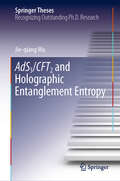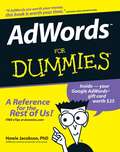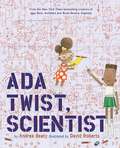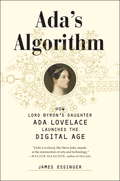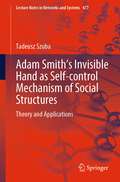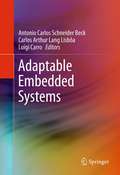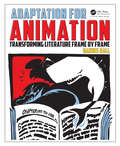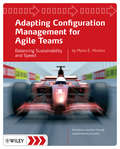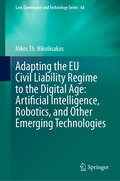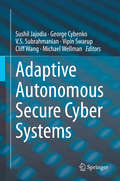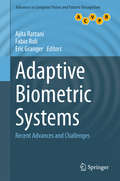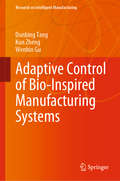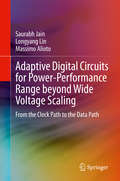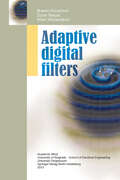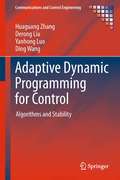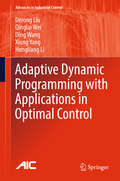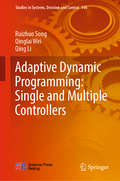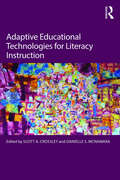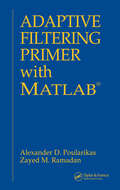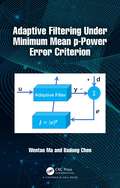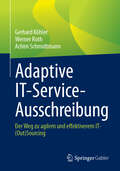- Table View
- List View
Ad-hoc, Mobile, and Wireless Networks: 14th International Conference, ADHOC-NOW 2015, Athens, Greece, June 29 -- July 1, 2015, Proceedings (Lecture Notes in Computer Science #9143)
by Symeon Papavassiliou Stefan RuehrupThis book constitutes the proceedings of the 14th International Conference on Ad Hoc Networks and Wireless, ADHOC-NOW 2015, held in Athens, Greece in June/July 2015. The 25 full papers presented in this volume were carefully reviewed and selected from 52 submissions. The book also contains 3 full-paper invited talks. The contributions are organized in topical sections named: routing, connectivity, and resource allocation; localization, sensor deployment, and mobility management; distributed computing with mobile agents; efficient, reliable, and secure smart energy networks; and emerging communications, networking and computing technologies for VANETs 2. 0.
Ad-hoc, Mobile, and Wireless Networks: 16th International Conference on Ad Hoc Networks and Wireless, ADHOC-NOW 2017, Messina, Italy, September 20-22, 2017, Proceedings (Lecture Notes in Computer Science #10517)
by Dario Bruneo Salvatore Distefano Antonio Puliafito Francesco LongoThis book constitutes the refereed proceedings of the 16th International Conference on Ad-hoc, Mobile, and Wireless Networks, ADHOC-NOW 2017, held in Messina, Italy, in September 2017. The 22 full and 9 short papers presented in this volume were carefully reviewed and selected from 55 submissions. The contributions were organized in topical sections named: internet of things; security; smart city; ad-hoc networks; implementations and validations; wireless sensor networks; data management; wireless systems.
AdS3/CFT2 and Holographic Entanglement Entropy (Springer Theses)
by Jie-qiang WuThis book focuses on AdS3/CFT2, addressing different aspects of this correspondence in field theory and in gravity, including entanglement entropy, higher genus partition function, and conformal block. Holographic entanglement entropy is an important area in holographic and quantum information, which implies a deep relation between geometry and quantum entanglement. In this book, the authors use holographic entanglement entropy as a tool to investigate AdS3/CFT2. They study the entanglement entropy at high temperature in field theory and in holographics, and show that the results match each other in classical and one-loop order. In the AdS3/CFT2 system, they examine in detail the correspondence, exploring the higher genus partition function, entanglement entropy in a general system and conformal block, and they find good correspondence in field theory and gravity. The result strongly supports AdS3/CFT2 correspondence. In addition, they develop several important techniques in 2d CFT and 3d gravity, which also offer inspiration for other fields.
AdWords For Dummies
by Howie JacobsonAdWords lets every business-from eBay PowerSellers to Fortune 500 companies-create targeted, cost-efficient advertising campaigns on the Web, and accounts for the bulk of Google's $6 billion in annual revenuesThis all-new guide helps advertisers get a handle on AdWords complexities and nuances, adopt AdWords best practices, and turn clicks into ka-ching!Topics covered include conducting quick and cheap market research, crafting a message that cuts through the clutter, choosing AdWords settings, bidding on keywords, setting a maximum daily spend, improving the Web page that an ad points to, testing strategies, tracking results, and using Web analytics toolsIncludes an exclusive offer from Google-AdWords credits equivalent to the price of the book-plus a companion Web site with up-to-the-minute AdWords tips and tricks, narrated video walkthroughs, and free trials of the author's software
Ada Lovelace
by Diane Stanley Jessie Hartland“A fascinating look at Ada Lovelace, the pioneering computer programmer and daughter of the poet Lord Byron."
Ada Twist, Scientist
by David Roberts Andrea BeatyLike her classmates, builder Iggy and inventor Rosie, scientist Ada, a character of color, has a boundless imagination and has always been hopelessly curious. Why are there pointy things stuck to a rose? Why are there hairs growing inside your nose? When her house fills with a horrific, toe-curling smell, Ada knows it’s up to her to find the source. What would you do with a problem like this? Not afraid of failure, Ada embarks on a fact-finding mission and conducts scientific experiments, all in the name of discovery. But, this time, her experiments lead to even more stink and get her into trouble! Inspired by real-life makers such as Ada Lovelace and Marie Curie, Ada Twist, Scientist champions girl power and women scientists, and brings welcome diversity to picture books about girls in science. Touching on themes of never giving up and problem solving, Ada comes to learn that her questions might not always lead to answers, but rather to more questions. She may never find the source of the stink, but with a supportive family and the space to figure it out, she’ll be able to feed her curiosity in the ways a young scientist should.
Ada's Algorithm
by James Essinger"Readers are treated to an intimate portrait of Lovelace's short but significant life along with an abbreviated history of 19th-century high-society London."--New CriterionOver 150 years after her death, a widely-used scientific computer program was named "Ada," after Ada Lovelace, the only legitimate daughter of the eighteenth century's version of a rock star, Lord Byron. Why?Because, after computer pioneers such as Alan Turing began to rediscover her, it slowly became apparent that she had been a key but overlooked figure in the invention of the computer.In Ada Lovelace, James Essinger makes the case that the computer age could have started two centuries ago if Lovelace's contemporaries had recognized her research and fully grasped its implications.It's a remarkable tale, starting with the outrageous behavior of her father, which made Ada instantly famous upon birth. Ada would go on to overcome numerous obstacles to obtain a level of education typically forbidden to women of her day. She would eventually join forces with Charles Babbage, generally credited with inventing the computer, although as Essinger makes clear, Babbage couldn't have done it without Lovelace. Indeed, Lovelace wrote what is today considered the world's first computer program--despite opposition that the principles of science were "beyond the strength of a woman's physical power of application."Based on ten years of research and filled with fascinating characters and observations of the period, not to mention numerous illustrations, Essinger tells Ada's fascinating story in unprecedented detail to absorbing and inspiring effect.From the Hardcover edition.
Adam Smith’s Invisible Hand as Self-control Mechanism of Social Structures: Theory and Applications (Lecture Notes in Networks and Systems #477)
by Tadeusz SzubaThis book shows how such a computational process functions, how great is its power and versatility, since it is possible to show how discoveries are made. In 1759, A. Smith realized that there must exist an additional powerful control mechanism behind Great Britain’s authority and government, explaining the extraordinary successes of Great Britain. He called this the Invisible Hand. Despite having used this term only 3 times, the idea evokes extreme scientific and political emotions to this day. If we apply a molecular model of computation, such as in in Adleman’s DNA computer, a computational model for the Invisible Hand can be built to show how it affects a society. It is a spontaneous, unconscious, distributed, noncontinuous computational process on the platform of minds of, e.g., people or ants. Knowing this mechanism, a future self-steering and self-optimization system for AI robot teams can be proposed, e.g., for construction sites and rescue operations.
Adaptable Embedded Systems
by Luigi Carro Carlos Arthur Lang Lisbôa Antonio Carlos BeckAs embedded systems become more complex, designers face a number of challenges at different levels: they need to boost performance, while keeping energy consumption as low as possible, they need to reuse existent software code, and at the same time they need to take advantage of the extra logic available in the chip, represented by multiple processors working together. This book describes several strategies to achieve such different and interrelated goals, by the use of adaptability. Coverage includes reconfigurable systems, dynamic optimization techniques such as binary translation and trace reuse, new memory architectures including homogeneous and heterogeneous multiprocessor systems, communication issues and NOCs, fault tolerance against fabrication defects and soft errors, and finally, how one can combine several of these techniques together to achieve higher levels of performance and adaptability. The discussion also includes how to employ specialized software to improve this new adaptive system, and how this new kind of software must be designed and programmed.
Adaptation for Animation: Transforming Literature Frame by Frame
by Hannes RallTalented animation artists often neglect successful storytelling in favor of strong visuals, but now you can have both with this complete guide to adaptation for animation. Veteran independent filmmaker Hannes Rall teaches you how to draw and adapt inspiration from copyright-free materials like fairy tales, myths, and classic literature, making it easier than ever to create your own compelling narrative. Particular focus is given to making the adequate narrative and visual choices when transferring a text from page to screen: How to create a successful adaptation. With sections on subjects like transcultural adaptations, visual poetry and production design, this book is just the right mix of practical advice, lavish illustrations, and industry case studies to give you everything you need to start adapting your story today. Key features: Learn to apply concepts of adapting classic and modern literature for animation in different techniques Exclusive interviews with animation legends Giannalberto Bendazzi, John Canemaker, Ishu Patel and Georges Schwizgebel Lavishly illustrated with 325 color images (mostly never published before) that give thrilling insights into the visual development of award-winning animated adaptations
Adapting Agricultural Extension to Peacebuilding: Roundtable on Technology, Science, and Peacebuilding
by Andrew RobertsonSocieties have sought to improve the outputs of their agricultural producers for thousands of years. In the 19th and early 20th centuries, efforts to convey agricultural knowledge to farmers became known as extension services, a term adopted from programs at Oxford and Cambridge designed to extend the knowledge generated at universities to surrounding communities. Traditionally, extension services have emphasized a top-down model of technology transfer that encourages and teaches producers to use crop and livestock varieties and agricultural practices that will increase food production. More recently, extension services have moved toward a facilitation model, in which extension agents work with producers to identify their needs and the best sources of expertise to help meet those needs. On May 1, 2012, the Roundtable on Science, Technology, and Peacebuilding held a workshop in Washington, DC, to explore whether and how extension activities could serve peacebuilding purposes. The Roundtable is a partnership between the National Academy of Engineering (NAE) and the U. S. Institute of Peace (USIP). It consists of senior executives and experts from leading governmental organizations, universities, corporations, and nongovernmental organizations, was established in 2011 to make a measurable and positive impact on conflict management, peacebuilding, and security capabilities. Its principal goals are: To accelerate the application of science and technology to the process of peacebuilding and stabilization; To promote systematic, high-level communication between peacebuilding and technical organizations on the problems faced and the technical capabilities required for successful peacebuilding; and To collaborate in applying new science and technology to the most pressing challenges for local and international peacebuilders working in conflict zones.
Adapting Configuration Management for Agile Teams
by Mario E. MoreiraAdapting Configuration Management for Agile Teams provides very tangible approaches on how Configuration Management with its practices and infrastructure can be adapted and managed in order to directly benefit agile teams. Written by Mario E. Moreira, author of Software Configuration Management Implementation Roadmap, columnist for CM Crossroads online community and writer for the Agile Journal, this unique book provides concrete guidance on tailoring CM for Agile projects without sacrificing the principles of Configuration Management.
Adapting the EU Civil Liability Regime to the Digital Age: Artificial Intelligence, Robotics, and Other Emerging Technologies (Law, Governance and Technology Series #68)
by Nikos Th. NikolinakosThis book highlights the challenges that artificial intelligence (AI), robotics, the Internet of Things (IoT), and other emerging digital technologies pose to existing EU and national liability legislation, while also tracing the evolution of the relevant EU policy and legal framework. Recognising that Member States’ current national fault-based liability rules are ill-suited to handle compensation claims for AI-related harm, the book emphasises the difficulty victims face in proving fault and causation due to AI’s unique characteristics, such as autonomy and opacity (“black box” effect). Similarly, the current Product Liability Directive (PLD) has several shortcomings: certain products, economic actors, and types of damage in the digital and circular economy are not covered under strict liability; proving defectiveness and establishing a causal link with damage, especially for complex products, is often challenging; in addition, liability claims are subject to restrictive limits and thresholds. The book discusses in detail the European Commission’s proposal for a Directive on harmonising civil liability rules for damage caused by AI systems (the ‘proposed AI Liability Directive’). It also offers a thorough analysis of the European Commission’s proposal for a revised Product Liability Directive, compares it with the positions of the Council of the EU and the European Parliament, and discusses the final text approved by the Plenary of the European Parliament in March 2024. The book incorporates comments from various parties, offering insights into the approaches of EU institutions and the conflicting interests among stakeholders. Presenting carefully grounded arguments, this volume serves as a valuable resource for understanding the interplay between policy and law within the new EU liability framework for AI and other innovative products. This forthcoming EU regime represents a significant shift in the liability landscape, potentially heightening litigation risks. Its success will depend on achieving the EU’s overarching objective: ensuring fair compensation while fostering technological innovation.
Adaptive Autonomous Secure Cyber Systems
by Sushil Jajodia Cliff Wang V. S. Subrahmanian Vipin Swarup George Cybenko Michael WellmanThis book explores fundamental scientific problems essential for autonomous cyber defense. Specific areas include:Game and control theory-based moving target defenses (MTDs) and adaptive cyber defenses (ACDs) for fully autonomous cyber operations;The extent to which autonomous cyber systems can be designed and operated in a framework that is significantly different from the human-based systems we now operate;On-line learning algorithms, including deep recurrent networks and reinforcement learning, for the kinds of situation awareness and decisions that autonomous cyber systems will require;Human understanding and control of highly distributed autonomous cyber defenses;Quantitative performance metrics for the above so that autonomous cyber defensive agents can reason about the situation and appropriate responses as well as allowing humans to assess and improve the autonomous system.This book establishes scientific foundations for adaptive autonomous cyber systems and ultimately brings about a more secure and reliable Internet. The recent advances in adaptive cyber defense (ACD) have developed a range of new ACD techniques and methodologies for reasoning in an adaptive environment.Autonomy in physical and cyber systems promises to revolutionize cyber operations. The ability of autonomous systems to execute at scales, scopes, and tempos exceeding those of humans and human-controlled systems will introduce entirely new types of cyber defense strategies and tactics, especially in highly contested physical and cyber environments. The development and automation of cyber strategies that are responsive to autonomous adversaries pose basic new technical challenges for cyber-security.This book targets cyber-security professionals and researchers (industry, governments, and military). Advanced-level students in computer science and information systems will also find this book useful as a secondary textbook.
Adaptive Biometric Systems: Recent Advances and Challenges (Advances in Computer Vision and Pattern Recognition)
by Ajita Rattani Fabio Roli Eric GrangerThis interdisciplinary volume presents a detailed overview of the latest advances and challenges remaining in the field of adaptive biometric systems. A broad range of techniques are provided from an international selection of pre-eminent authorities, collected together under a unified taxonomy and designed to be applicable to any pattern recognition system. Features: presents a thorough introduction to the concept of adaptive biometric systems; reviews systems for adaptive face recognition that perform self-updating of facial models using operational (unlabeled) data; describes a novel semi-supervised training strategy known as fusion-based co-training; examines the characterization and recognition of human gestures in videos; discusses a selection of learning techniques that can be applied to build an adaptive biometric system; investigates procedures for handling temporal variance in facial biometrics due to aging; proposes a score-level fusion scheme for an adaptive multimodal biometric system.
Adaptive Control of Bio-Inspired Manufacturing Systems (Research on Intelligent Manufacturing)
by Dunbing Tang Kun Zheng Wenbin GuThis book introduces state-of-the-art models and methods based on the neuroendocrine-immune-inspired approaches in the field of manufacturing control systems. It develops various bio-inspired intelligent approaches for multiple applications in order to efficiently generate production plans and control solutions and agilely deal with the frequent unexpected disturbances at the shop floor level. It also provides an introduction to bio-inspired manufacturing systems with intelligent control structures and the latest technologies. Further, the book describes recent advances in the bio-inspired methodology for a high-level adaptability in manufacturing systems, including the bio-inspired control architecture and the implementation of intelligent and adaptive control approaches based on neuroendocrine-immune mechanisms and hormone-regulation principles. It offers a valuable resource for graduate students, researchers and engineers in the fields of production management, manufacturing system control and related areas.
Adaptive Digital Circuits for Power-Performance Range beyond Wide Voltage Scaling: From the Clock Path to the Data Path
by Massimo Alioto Saurabh Jain Longyang LinThis book offers the first comprehensive coverage of digital design techniques to expand the power-performance tradeoff well beyond that allowed by conventional wide voltage scaling. Compared to conventional fixed designs, the approach described in this book makes digital circuits more versatile and adaptive, allowing simultaneous optimization at both ends of the power-performance spectrum. Drop-in solutions for fully automated and low-effort design based on commercial CAD tools are discussed extensively for processors, accelerators and on-chip memories, and are applicable to prominent applications (e.g., IoT, AI, wearables, biomedical). Through the higher power-performance versatility techniques described in this book, readers are enabled to reduce the design effort through reuse of the same digital design instance, across a wide range of applications. All concepts the authors discuss are demonstrated by dedicated testchip designs and experimental results. To make the results immediately usable by the reader, all the scripts necessary to create automated design flows based on commercial tools are provided and explained.
Adaptive Digital Filters
by Zoran Banjac Milan Milosavljević Branko Kovačević"Adaptive Digital Filters" presents an important discipline applied to the domain of speech processing. The book first makes the reader acquainted with the basic terms of filtering and adaptive filtering, before introducing the field of advanced modern algorithms, some of which are contributed by the authors themselves. Working in the field of adaptive signal processing requires the use of complex mathematical tools. The book offers a detailed presentation of the mathematical models that is clear and consistent, an approach that allows everyone with a college level of mathematics knowledge to successfully follow the mathematical derivations and descriptions of algorithms. The algorithms are presented in flow charts, which facilitates their practical implementation. The book presents many experimental results and treats the aspects of practical application of adaptive filtering in real systems, making it a valuable resource for both undergraduate and graduate students, and for all others interested in mastering this important field.
Adaptive Dynamic Programming for Control: Algorithms and Stability (Communications and Control Engineering)
by Yanhong Luo Huaguang Zhang Ding Wang Derong LiuThere are many methods of stable controller design for nonlinear systems. In seeking to go beyond the minimum requirement of stability, Adaptive Dynamic Programming in Discrete Time approaches the challenging topic of optimal control for nonlinear systems using the tools of adaptive dynamic programming (ADP). The range of systems treated is extensive; affine, switched, singularly perturbed and time-delay nonlinear systems are discussed as are the uses of neural networks and techniques of value and policy iteration. The text features three main aspects of ADP in which the methods proposed for stabilization and for tracking and games benefit from the incorporation of optimal control methods: * infinite-horizon control for which the difficulty of solving partial differential Hamilton-Jacobi-Bellman equations directly is overcome, and proof provided that the iterative value function updating sequence converges to the infimum of all the value functions obtained by admissible control law sequences; * finite-horizon control, implemented in discrete-time nonlinear systems showing the reader how to obtain suboptimal control solutions within a fixed number of control steps and with results more easily applied in real systems than those usually gained from infinite-horizon control; * nonlinear games for which a pair of mixed optimal policies are derived for solving games both when the saddle point does not exist, and, when it does, avoiding the existence conditions of the saddle point. Non-zero-sum games are studied in the context of a single network scheme in which policies are obtained guaranteeing system stability and minimizing the individual performance function yielding a Nash equilibrium. In order to make the coverage suitable for the student as well as for the expert reader, Adaptive Dynamic Programming in Discrete Time: * establishes the fundamental theory involved clearly with each chapter devoted to a clearly identifiable control paradigm; * demonstrates convergence proofs of the ADP algorithms to deepen understanding of the derivation of stability and convergence with the iterative computational methods used; and * shows how ADP methods can be put to use both in simulation and in real applications. This text will be of considerable interest to researchers interested in optimal control and its applications in operations research, applied mathematics computational intelligence and engineering. Graduate students working in control and operations research will also find the ideas presented here to be a source of powerful methods for furthering their study.
Adaptive Dynamic Programming with Applications in Optimal Control (Advances in Industrial Control)
by Ding Wang Derong Liu Qinglai Wei Xiong Yang Hongliang LiThis book covers the most recent developments in adaptive dynamic programming (ADP). The text begins with a thorough background review of ADP making sure that readers are sufficiently familiar with the fundamentals. In the core of the book, the authors address first discrete- and then continuous-time systems. Coverage of discrete-time systems starts with a more general form of value iteration to demonstrate its convergence, optimality, and stability with complete and thorough theoretical analysis. A more realistic form of value iteration is studied where value function approximations are assumed to have finite errors. Adaptive Dynamic Programming also details another avenue of the ADP approach: policy iteration. Both basic and generalized forms of policy-iteration-based ADP are studied with complete and thorough theoretical analysis in terms of convergence, optimality, stability, and error bounds. Among continuous-time systems, the control of affine and nonaffine nonlinear systems is studied using the ADP approach which is then extended to other branches of control theory including decentralized control, robust and guaranteed cost control, and game theory. In the last part of the book the real-world significance of ADP theory is presented, focusing on three application examples developed from the authors' work: * renewable energy scheduling for smart power grids; * coal gasification processes; and * water-gas shift reactions. Researchers studying intelligent control methods and practitioners looking to apply them in the chemical-process and power-supply industries will find much to interest them in this thorough treatment of an advanced approach to control.
Adaptive Dynamic Programming: Single and Multiple Controllers (Studies in Systems, Decision and Control #166)
by Qing Li Qinglai Wei Ruizhuo SongThis book presents a class of novel optimal control methods and games schemes based on adaptive dynamic programming techniques. For systems with one control input, the ADP-based optimal control is designed for different objectives, while for systems with multi-players, the optimal control inputs are proposed based on games. In order to verify the effectiveness of the proposed methods, the book analyzes the properties of the adaptive dynamic programming methods, including convergence of the iterative value functions and the stability of the system under the iterative control laws. Further, to substantiate the mathematical analysis, it presents various application examples, which provide reference to real-world practices.
Adaptive Educational Technologies for Literacy Instruction
by Scott A. Crossley Danielle S. McNamaraWhile current educational technologies have the potential to fundamentally enhance literacy education, many of these tools remain unknown to or unused by today’s practitioners due to a lack of access and support. Adaptive Educational Technologies for Literacy Instruction presents actionable information to educators, administrators, and researchers about available educational technologies that provide adaptive, personalized literacy instruction to students of all ages. These accessible, comprehensive chapters, written by leading researchers who have developed systems and strategies for classrooms, introduce effective technologies for reading comprehension and writing skills.
Adaptive Filtering Primer with MATLAB
by Alexander D. Poularikas Zayed M. Ramadan<p>Because of the wide use of adaptive filtering in digital signal processing and, because most of the modern electronic devices include some type of an adaptive filter, a text that brings forth the fundamentals of this field was necessary. The material and the principles presented in this book are easily accessible to engineers, scientists, and students who would like to learn the fundamentals of this field and have a background at the bachelor level. <p>Adaptive Filtering Primer with MATLAB clearly explains the fundamentals of adaptive filtering supported by numerous examples and computer simulations. The authors introduce discrete-time signal processing, random variables and stochastic processes, the Wiener filter, properties of the error surface, the steepest descent method, and the least mean square (LMS) algorithm. They also supply many MATLAB functions and m-files along with computer experiments to illustrate how to apply the concepts to real-world problems. The book includes problems along with hints, suggestions, and solutions for solving them. An appendix on matrix computations completes the self-contained coverage. <p>With applications across a wide range of areas, including radar, communications, control, medical instrumentation, and seismology, Adaptive Filtering Primer with MATLAB is an ideal companion for quick reference and a perfect, concise introduction to the field.</p>
Adaptive Filtering Under Minimum Mean p-Power Error Criterion
by Badong Chen Wentao MaAdaptive filtering still receives attention in engineering as the use of the adaptive filter provides improved performance over the use of a fixed filter under the time-varying and unknown statistics environments. This application evolved communications, signal processing, seismology, mechanical design, and control engineering. The most popular optimization criterion in adaptive filtering is the well-known minimum mean square error (MMSE) criterion, which is, however, only optimal when the signals involved are Gaussian-distributed. Therefore, many "optimal solutions" under MMSE are not optimal. As an extension of the traditional MMSE, the minimum mean p-power error (MMPE) criterion has shown superior performance in many applications of adaptive filtering. This book aims to provide a comprehensive introduction of the MMPE and related adaptive filtering algorithms, which will become an important reference for researchers and practitioners in this application area. The book is geared to senior undergraduates with a basic understanding of linear algebra and statistics, graduate students, or practitioners with experience in adaptive signal processing.Key Features: Provides a systematic description of the MMPE criterion. Many adaptive filtering algorithms under MMPE, including linear and nonlinear filters, will be introduced. Extensive illustrative examples are included to demonstrate the results.
Adaptive IT-Service-Ausschreibung: Der Weg zu agilem und effektiverem IT-(Out)Sourcing
by Gerhard Köhler Werner Roth Achim SchmidtmannAusschreibungen für IT Managed Services haben sich weiterentwickelt, aber Bereiche, die entscheidend für den Geschäftswert der Kunden sind, wurden bisher kaum verbessert. Wenn die Zusammenarbeit zwischen IT-Dienstleister und Kunde ins Stocken gerät, ist der nächste Innovationszyklus eine erneute Ausschreibung in frühestens drei Jahren. Diesen Zeitverlust können sich immer weniger Branchen leisten. Adaptive IT-Ausschreibungen verkürzen den Zeitraum und legen den Fokus auf Innovation und Zusammenarbeit. Dabei eignen sich adaptive Ansätze nicht nur für agile Unternehmen, sondern auch für traditionelle Organisationen. Mit diesem Buch erhalten alle Akteure, die an der Ausschreibung und dem Betrieb von Managed IT Services beteiligt sind, ein Methodenset für adaptive Ausschreibungen. Unabhängig davon, ob die Rolle in der Geschäftsleitung, im Management, in der Fachabteilung, in der IT, im Vertrieb, im Einkauf, in der Rechtsabteilung, in der Beratung oder im Betrieb angesiedelt ist, werden die Methoden detailliert und im Vergleich zu traditionellen Vorgehensweisen dargestellt. Ein Glossar hilft dabei, letzte Wissenslücken zu schließen.
